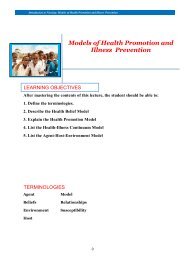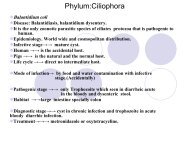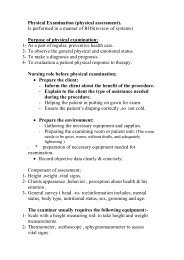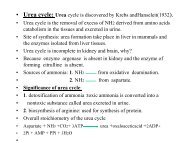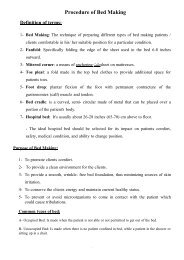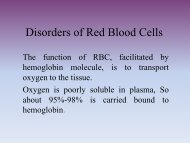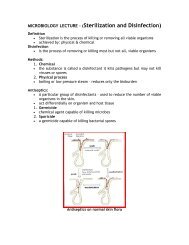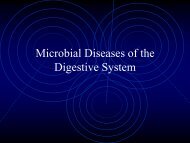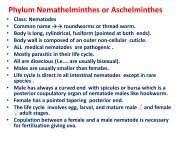Pathophysiology =Physiology of altered health
Pathophysiology =Physiology of altered health
Pathophysiology =Physiology of altered health
Create successful ePaper yourself
Turn your PDF publications into a flip-book with our unique Google optimized e-Paper software.
<strong>Pathophysiology</strong><br />
<strong>=Physiology</strong> <strong>of</strong> <strong>altered</strong> <strong>health</strong><br />
It is mainly concerned with the physiological<br />
changes and responses that produce signs<br />
and symptoms in case <strong>of</strong> disease.<br />
So studying <strong>of</strong> pathophysiology is essential<br />
to understanding the rational for medical and<br />
surgical therapy.
Disease<br />
• Inherited disease: Due to abnormality in the<br />
DNA <strong>of</strong> the fertilized ovum and the cell<br />
derived from it.<br />
• Acquired Disease: Due to effect <strong>of</strong> some<br />
environmental factors.
Pathogenesis<br />
• It means the mechanism <strong>of</strong> disease<br />
development.<br />
each disease has a characteristic natural<br />
history, a typical pattern <strong>of</strong> evolution, effect<br />
and duration that is observed.
Manifestation<br />
• the etiologic agent may provoke a number <strong>of</strong><br />
changes in the biological process, that lead to<br />
produce clinical signs.<br />
• Many diseases have a subclinical stage.
The cell
The Cell<br />
The cell is composed <strong>of</strong> protoplasm<br />
1. Water (70-85%).<br />
The protoplasm is composed <strong>of</strong>:<br />
2. Proteins (10-20)% which form cell structures ,<br />
enzymes.<br />
3. Lipiods (2-3)%<br />
4. Small amounts <strong>of</strong> carbohydratesare used as fuel.<br />
5. Electrolytes major intracellular electrolytes are,<br />
K, Mg, PO4, SO4, HCO3 and small quantity <strong>of</strong><br />
CL, Na, Ca, Fl.
Cell Membrane
Cell Membrane
cell membrane surrounded the cell and prevent content <strong>of</strong> the<br />
cell get out and prevent molecules from environment to get<br />
inside the cell. This membrane is semi-permeable.<br />
• Component <strong>of</strong> cell membrane:<br />
• lipids (phospholipids, and cholesterol)<br />
• Proteins<br />
• Carbohydrate
Cytoplasm<br />
• Cytoplasm is a colloidal solusion that contains<br />
water, electrolytes, suspended proteins, neutral<br />
fats, and glycogen molecules.<br />
In the cytoplasm there are organelles.<br />
Organelles: inner organ <strong>of</strong> the cell.
Ribosomes
Rough Endoplasmic Reticulum
Rough & Smooth Reticulum<br />
Endoplasmic
Golgi’s Apparatus<br />
.<br />
Function:<br />
It packages substances<br />
(which are synthesized in<br />
the cell) into secretory<br />
granules.
Mitochondria
Microtubules<br />
The microtubules are slender tubular<br />
structures composed <strong>of</strong> globular proteins<br />
called tubulin microtubules control cell shape<br />
and movement.<br />
Function:<br />
1. Development and maintenance <strong>of</strong> cell<br />
form.<br />
2. Particepation in intracellular transport<br />
mechanisms.<br />
3. Formation <strong>of</strong> centrioles.
Microtubules and Centrioles
Centriole
Centrioles are cylindrical structure<br />
composed <strong>of</strong> highly organized microtubules.<br />
In dividing cells they form the mitotic<br />
spindle that aids in the separation and<br />
movement <strong>of</strong> chromosomes.
• It is control center <strong>of</strong> the<br />
cell. It is surrounded by<br />
nuclear membrane and<br />
it contains the<br />
individual units which is<br />
called genes.<br />
Nucleus
Genes<br />
• Are units <strong>of</strong> inheritance which are strung a<br />
long the chromosomes<br />
• Gene control cell activity by determining the<br />
type <strong>of</strong> protein that is that being synthesized<br />
in the cytoplasm.
Chromosome<br />
• Is a double strand helical molecule <strong>of</strong> DNA<br />
containing variable sequences <strong>of</strong> four<br />
nitrogen bases(thymine, Guanine, Cytosine,<br />
and Adenine) these bases form a gene.etic<br />
code.
Cellular Adaptation<br />
Cells have ability to adapt when there is change<br />
in environment or when increase work<br />
demands.<br />
Changing in size.<br />
Cellular adaptation occurs by:<br />
Changing in cells number<br />
Changing in cells type.
Atrophy<br />
Decrease in the cell size.<br />
Causes<br />
Disuse<br />
Endocrine stimulation<br />
Malnutrition<br />
Decrease in blood supply.<br />
De- enervation
Atrophy:<br />
a). Brain<br />
This is<br />
cerebral<br />
atrophy in a<br />
patient with<br />
Alzheimer's<br />
disease. The<br />
gyri are<br />
narrowed and<br />
the sulci<br />
widened<br />
toward to<br />
frontal pole.
Hypertrophy<br />
• Increase in cell size
This is cardiac hypertrophy. The number <strong>of</strong> myocardial fibers<br />
never increases, but their size can increase in response to an<br />
increased workload, leading to the marked thickening <strong>of</strong> the<br />
left ventricle in this patient with hypertension.
The main complication <strong>of</strong> Persistant<br />
hypertrophy is cardiac failure.
Hyperplasia<br />
Increase in the number <strong>of</strong> cells in the organ or<br />
tissue.<br />
Hyperplasia is a controlled process that occurs in<br />
response to an appropriate stimulus and cease<br />
once the stimulus has been removed.
Hyperplasia in the skin<br />
Occurs in case <strong>of</strong> Psoriasis
Metaplasia<br />
• It means conversion from one tissue to another<br />
type like simple epithelium converted to<br />
stratified epithelium.<br />
• Chronic irritation<br />
• Persist inflammation<br />
Causes:
IV. Metaplasia
Dysplasia<br />
• Deranged cell growth <strong>of</strong> a specific tissue that<br />
results in cells which vary in size shape and<br />
appearance.<br />
• Chronic irritation<br />
Causes
Injury & Cell Death<br />
• Injury:<br />
Any abnormal changes in cell induced by<br />
causal agent.<br />
Cell injury is<br />
reversible up to certain point.<br />
if the stimulus persists or<br />
sever enough from the beginning<br />
The cell reaches to “ point <strong>of</strong> no return”.
There are two effects <strong>of</strong> cellular<br />
injury:<br />
Cell death:<br />
There is irreversible changes occur in<br />
the cell and there is no further integrated<br />
function occur like respiration<br />
Lesser form <strong>of</strong> damage:<br />
Reversible changes and also called<br />
degeneration
Cell Death<br />
Cell death means number <strong>of</strong> cells in the<br />
certain tissue are dead.<br />
Somatic death means death <strong>of</strong> individual (all<br />
body).
Necrobiosis: Cell death due to end the<br />
physiological age <strong>of</strong> the cell<br />
Necrosis : Death occurs due to exposure<br />
to injurious agent.<br />
Apoptosis: Cell death occurs in case <strong>of</strong><br />
physiological cell death or<br />
due to irreversible cell<br />
damage.
Apoptosis<br />
death <strong>of</strong> single<br />
cell by shrinkage<br />
<strong>of</strong> cell, then small<br />
parts drop <strong>of</strong>f and<br />
are engulfed by<br />
macrophage.
Necrosis<br />
Causes <strong>of</strong><br />
• Marked impaired <strong>of</strong> blood supply.<br />
• Toxin and chemical poisonous.<br />
• Immunological injury.<br />
• Physical agents.<br />
• Infection.
Necrosis is recognized by:<br />
1). Changes in cytoplasmic staining<br />
The cytoplasm becomes more eosinophilic due<br />
to increase affinity to acidic dyes.
2). Changes in the nucleus:<br />
a). Pyknosis – condensation <strong>of</strong> chromatin<br />
and shrinkage <strong>of</strong> the nucleus<br />
b). Karyorrhexis - fragmentation<br />
nucleus<br />
<strong>of</strong> the<br />
C). Karyolysis - dissolution <strong>of</strong><br />
nucleus by the action <strong>of</strong><br />
deoxyribonuclease .<br />
the
2) Changes in cytoplasmic<br />
staining:<br />
The cytoplasm becomes more<br />
eosinophilic due to increase affinity<br />
to acidic dyes.<br />
•
Microscopic appearance <strong>of</strong> the<br />
necrotic tissue:<br />
The tissue appears more<br />
eosinophilic than the normal.<br />
Cellular details disappear, so<br />
there is no nucleus (only<br />
fragments <strong>of</strong> nucleus may be<br />
seen) and the boundary <strong>of</strong> the<br />
cell disappears<br />
•
Types <strong>of</strong> necrosis:<br />
Coagulative necrosis:<br />
the tissue appears paler than normal<br />
adjacent tissue but the architecture <strong>of</strong><br />
the tissue is maintained.
Gaseous necrosis:<br />
This type <strong>of</strong> necrosis has a s<strong>of</strong>t cheesy<br />
like center.<br />
It most commonly associated with<br />
T.B.<br />
•<br />
In this type <strong>of</strong> necrosis the<br />
architecture <strong>of</strong> the tissue disappears.
Liquefactive necrosis:<br />
Occurs in s<strong>of</strong>t tissues which contains<br />
which contain high amounts <strong>of</strong> fat<br />
like brain tissue, and also in case <strong>of</strong><br />
abscess when large amount or<br />
numbers <strong>of</strong> nutrophils enter the<br />
infected area and when nutrophils<br />
die that allows lysosomal enzymes to<br />
release and digest the tissue, so we<br />
can see cavity containing fluids.
The contents <strong>of</strong> pus are:<br />
Pyogenic bacteria (dead<br />
and life)<br />
Nutrophils (dead and<br />
life)<br />
dead tissue.<br />
•
Fat Necrosis<br />
It occurs due to damage to the pancreas which<br />
leads to release the lipase enzyme. This<br />
enzyme attack fat tissues and lyses fat.<br />
•
Gangrene
Gangrene<br />
The term gangrene means digestion <strong>of</strong> dead<br />
tissue by saprophytic bacteria (i.e. bacteria<br />
which are incapable <strong>of</strong> invading and<br />
multiplying in living tissue). And it associated<br />
with foul odor and the color <strong>of</strong> the tissue<br />
changes into dark brown or greenish brown.
Gangrene may be either :<br />
Primary : which necrosis (death) <strong>of</strong> tissue is due<br />
to production <strong>of</strong> exotoxins by bacteria (which<br />
may then invade and digest the dead tissue).<br />
Secondary : which necrosis <strong>of</strong> tissue is due to<br />
other cause like obstruction <strong>of</strong> blood supply<br />
lead to necrosis and then invasion by bacteris.
Primary Gangrene<br />
Like gas gangrene caused by group <strong>of</strong> bacteria<br />
called Clostridia especially Clostridia welchii ,<br />
Clostridium perifrenges, Clostridia oedematous<br />
and Clostridia septicum.<br />
These organisms are intestinal commensals in man<br />
and animals.<br />
These organisms are anaerobic and saprophytic.
Their spores are widespread, and are liable to<br />
contaminate wounds, but they flourish blood<br />
soaked foreign material and dead tissue in<br />
dirty puncture or lacerated wounds.<br />
The Clostridia produce exotoxins which<br />
diffuse into and kill the adjacent tissues and<br />
these in turn are invaded
Clostridia produce H2 and CO2 which collect as<br />
bubbles in the dead tissues, rendering them<br />
crepitant on palpation.<br />
Gas gangrene is accompanied by acute<br />
hemolysis and sever toxemia.
Secondary Gangrene<br />
Usually result <strong>of</strong> ischemic necrosis followed by<br />
invasion and digestion <strong>of</strong> dead tissue by<br />
putrefactive micro-organisms.<br />
It is most <strong>of</strong>ten occur in the foot and leg and in<br />
the intestine.<br />
It is <strong>of</strong> two forms wet and dry gangrene.
Dry gangrene: Occurs in the part <strong>of</strong> body when<br />
there is no excessive fluids like in leg when<br />
infraction preceded by gradual arterial<br />
occlusion. The skin becomes cold and waxy.<br />
Occurs in the part <strong>of</strong> body when<br />
Wet gangrene:<br />
there is excessive fluid ischemic in ischemic<br />
area like intestine and edematous leg.
Dry Gangrene
Wet Gangrene
Gangrene



